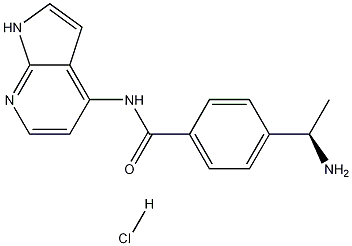
Y-39983 hydrochloride
- Product NameY-39983 hydrochloride
- CAS471843-75-1
- CBNumberCB32509933
- MFC16H16N4O.HCl
- MW316.78538
- MOL File471843-75-1.mol
- MSDS FileSDS
Y-39983 hydrochloride Chemical Properties,Usage,Production
Description
Y-39983 hydrochloride, also known as Y-33075, is a selective Rho-associated coiled coil-forming protein kinase (ROCK) inhibitor derived from Y-27632, and is more potent than Y-27632, with an IC50 of 3.6 nM.in vitro
In rabbits, topical administration of Y-39983 significantly increased conventional outflow by 65.5%, followed by significant, dose-dependent reduction in IOP. Maximum IOP reduction was 13.2 ± 0.6 mm Hg (mean ± SE) at 0.1% Y-39983 in rabbits. In monkeys, at 3 hours after topical administration of 0.05% Y-39983, maximum reduction of IOP was 2.5 ± 0.8 mm Hg. No serious side effects were observed in ocular tissues except sporadic punctate subconjunctival hemorrhage during long-term topical administration of Y-39983 four times a day (at 2-hour intervals) in rabbits or monkeys. However, punctate subconjunctival hemorrhage was not observed with administration twice daily (at a 6-hour interval) or three times a day (at 5-hour intervals).References
[1]. Hideki Tokushige, et al. Effects of Topical Administration of Y-39983, a Selective Rho-Associated Protein Kinase Inhibitor, on Ocular Tissues in Rabbits and Monkeys Invest. Ophthalmol. Vis. Sci. July 2007 vol. 48no. 7 3216-3222 DOI:10.1167/IOVS.05-1617[2]. Tokushige H, et al. Effects of Y-39983, a selective Rho-associated protein kinase inhibitor, on blood flow in optic nerve head in rabbits and axonal regeneration of retinal ganglion cells in rats. Curr Eye Res. 2011 Oct;36(10):964-70. DOI:10.3109/02713683.2011.599106
[3]. Watabe H, et al. Effects of Rho-associated protein kinase inhibitors Y-27632 and Y-39983 on isolated rabbit ciliary arteries.Jpn J Ophthalmol. 2011 Jul;55(4):411-7. Epub 2011 Jun 11. DOI:10.1007/s10384-011-0048-9
Preparation Products And Raw materials
Y-39983 hydrochloride Suppliers
Global(19)Suppliers
| Supplier | Tel | Country | ProdList | Advantage | |
|---|---|---|---|---|---|
| 86-13657291602 | linda@hubeijusheng.com | CHINA | 22963 | 58 | |
| +8618523575427 | sales@conier.com | China | 49374 | 58 | |
| +86-029-89586680 +86-18192503167 |
1026@dideu.com | China | 7724 | 58 | |
| +undefined18051384581 | sales@chemhifuture.com | China | 3135 | 58 | |
| 18149758185 18149758185 |
sales-cpd@caerulumpharma.com | China | 3466 | 58 | |
| 021-65675885 18964387627 |
info@efebio.com | China | 9806 | 58 | |
| 15971444841 | amber@biochempartner.com | China | 3061 | 58 | |
| 021-58447131 13564518121 |
sales@dcchemicals.com | China | 9409 | 58 | |
| 13969155946 | 1461866103@qq.com | China | 16111 | 58 | |
| 18051384581 | sales@chemhifuture.com | China | 3021 | 58 |
View Lastest Price from Y-39983 hydrochloride manufacturers

PROMPT×
PROMPT
The What'sApp is temporarily not supported in mainland China
The What'sApp is temporarily not supported in mainland China
Cancel
Determine